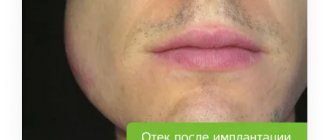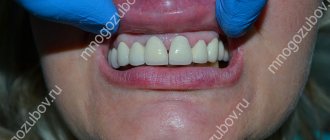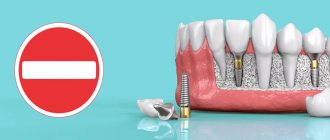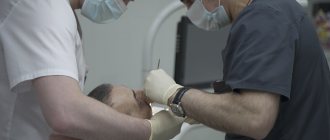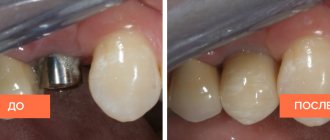Fixation of the titanium root in the jaw bone can occur by puncturing or cutting the mucosa, followed by the formation of a bed with a drill. In both cases, damage to soft tissues and blood vessels occurs, and active irritation of nerve endings occurs. During surgery, discomfort is relieved by anesthesia. After 1-1.5 hours, the effect of the anesthetics stops, and tissue sensitivity returns. Pain after dental implantation is a normal reaction of the body. The symptom requires attention because it reduces the patient’s quality of life, and sometimes indicates the development of early postoperative complications.
Is aching pain after implant placement normal?
Implant surgery may be accompanied by temporary side effects:
- pain in the tooth and gum area;
- swelling of the gums, their bleeding;
- slight increase in body temperature;
- the presence of small hematomas.
Such symptoms are called early complications that accompany each surgical intervention. They are considered standard consequences that arise from a successful outcome of the operation and do not pose a threat to health. Correct installation of the prosthesis may be accompanied by aching pain in the gum and tooth area. This is due to the process of implantation of a foreign object into the tissue. The pain goes away after 3-4 days. It is during this period that the implant is accepted by living tissue.
If the operation is performed incorrectly, the implant may be rejected, the early signs of which are incessant pain in the gums, adjacent teeth, and a sharp increase in temperature.
Pain due to peri-implantitis
Another common complication that patients experience several months or years after dental surgery is peri-implantitis. Inflammatory disease develops inside the periodontium and often causes further rejection of the metal rod. The first signs are:
- violation of the outflow of lymph from the gums, its swelling and itching;
- a burning sensation begins inside;
- the implant is bothered by a tugging pain, which worsens when lying down, during physical activity or after lunch;
- sometimes a translucent exudate is released.
The cause of peri-implantitis in 95% of cases is microorganisms. They easily enter the bone tissue with the blood flow from molars affected by caries, from an abscess or purulent fistula. The process occurs against a background of weakened immunity or previous flu, so the implant may still bother you a year after installation.
When should the pain go away?
Pain during the rehabilitation period is present after any surgical intervention. Implantation is no exception. Aching pain in the gums appears after the anesthesia wears off and can last for several days. It is important to monitor the intensity of pain and well-being. Normally, pain should not persist for more than three days. The duration of pain depends on the physiological characteristics of the body.
The doctor will give recommendations regarding treatment during the rehabilitation period. Ignoring therapy can significantly prolong recovery time.
How are dental implants removed?
Is it difficult to remove a dental implant? Yes and no. On the one hand, the mechanical side of the matter is extremely simple. It is not difficult to unscrew an implant from the jaw (especially if it is movable), but only an experienced implantologist can do this correctly and as non-traumaticly as possible. In addition, important blood vessels and nerve bundles often pass through the implantation area, so damage to them can cause additional serious complications. In general, implant removal usually takes one visit and takes place in several stages.
- The doctor removes the crown or full denture.
- An incision is made in the gum.
- The implant is removed.
- If necessary, appropriate therapeutic or surgical manipulations are performed (treatment of affected areas, plastic surgery of soft and hard tissues).
- After identifying the cause of rejection, a subsequent rehabilitation plan is developed.
Implant removal usually occurs under local anesthesia or sedation. If everything is done correctly, the consequences of removing a dental implant will be relatively mild and the patient will be able to recover in a short period. After completion of the rehabilitation period, in most cases, re-implantation is possible, unless absolute contraindications to the procedure have been identified. It is quite difficult to find reviews on the Internet about the removal of a dental implant (even less about complications), but if it is done by a professional, then you have nothing to fear.
If complications occur, you should contact the same clinic where the treatment was performed. If implant rejection was not your fault, then most dentists undertake to provide free treatment and a repeat implantation procedure (or return the money if it is not possible). In addition, almost all major manufacturers also provide a lifetime warranty on their products. Startsmile recommends undergoing treatment in trusted clinics that offer an appropriate guarantee.
Why complications may occur
To minimize the risk of complications, the doctor must make sure that implantation is not contraindicated and the patient’s body can bear the load. There are relative and absolute contraindications.
Relative contraindications are:
- pregnancy, lactation;
- treatment with hormones, chemotherapy;
- age over 60 years;
- bad habits;
- type 2 diabetes mellitus;
- jaw injuries;
- cariogenic situation in the oral cavity;
- chronic diseases.
Installation of implants in these cases may have a long recovery period. The pain may persist for several weeks.
Difficult implantation is also observed in the case of:
- non-compliance with installation technology;
- lack of proper oral care in the postoperative period;
- refusal of therapy during rehabilitation.
Implantation is not possible if:
- HIV infections;
- chronic diseases of bone and connective tissue;
- blood diseases;
- oncology;
- diseases of the lungs, kidneys, liver;
- endocrine diseases.
The absence of contraindications does not guarantee the absence of complications. The qualifications of the doctor play a huge role. A competent specialist will promptly eliminate any complications that arise and prevent their development.
Symptoms of implanted teeth rejection
Even an experienced dentist cannot predict how a patient’s jaw bone will behave when it comes into contact with a metal rod. Much depends not only on the skill of the doctor, but also on the individual characteristics of the body:
- tendency to allergies to metals;
- immunity status;
- the rate of cell regeneration of mucous and porous tissues;
- proper oral care;
- hidden chronic infections.
The process of bone restoration and implant healing begins a few days after the procedure. During the normal course, swelling, burning and itching gradually subside, bleeding disappears and the wound heals. But rejection can begin even after a year, when a person is completely accustomed to the new tooth and has forgotten about the unpleasant sensations. This is affected by deteriorating health, constant work with chemicals and reagents, and the appearance of hormonal imbalances. Sometimes, due to severe diseases, bones throughout the body suffer, the jaw structure becomes fragile and does not hold the pin in place.
In case of rejection, you should definitely see a treating specialist. Otherwise, the risk of developing inflammation inside the periodontium, which will affect the roots of healthy molars, greatly increases. Therefore, you should know the possible symptoms:
- the implant hurts a year after installation (sometimes the process begins 3–5 years later due to the development of oncology or diabetes);
- a little blood or purulent fluid appears from under the crown;
- the gums change color to dark red or bluish;
- swelling appears near the inflamed area.
In advanced situations, when pressing on an artificial tooth, its mobility is felt. The patient has difficulty biting off an apple or chewing meat, and there is an acute reaction to a hot drink or cold ice cream.
What can cause pain during the healing process?
The engraftment process is purely individual. Complications during the engraftment process are caused by:
- Decreased immunity.
- Exacerbation of chronic diseases.
- Infections.
- Injury to the maxillofacial apparatus.
- Failure to comply with the surgical protocol.
- Overheating of the bone during implantation.
- Formation of a blood clot between the implant and the gum.
- Insufficient hygiene.
Poor hygiene promotes the development of bacteria that penetrate under the gums and cause inflammation. Next, the infection descends into the deep layers of tissue surrounding the implant, where it causes inflammation of the bone structure.
What to do if there is aching or sharp pain and swelling
Dull aching pain for a short time in the postoperative period is normal. To alleviate it and prevent the development of acute pain, you need to follow the following recommendations:
- Apply cold compresses. A cold pack is applied to the side where the operation was performed at intervals of 20 minutes. A break is necessary to prevent hypothermia. Cold application can be carried out within one and a half days after surgery.
- Wipe soft tissues with a special solution. You need to make it yourself from: 1 tsp. salt, five drops of iodine, 200 ml of water.
- You can take a painkiller 2 hours after surgery. The permissible interval between doses of analgesics is 4 hours.
- Maintain oral hygiene to avoid infection. When brushing your teeth, do not touch the implantation site with a brush, but wipe with a cotton swab and saline solution.
- Temporarily avoid solid, hot, spicy foods.
Acute pain indicates inflammation and requires urgent medical attention.
Pharmacy medicines
To relieve swelling from soft tissues, the following is prescribed:
- Chlorhexidine bigluconate 0.5% . Rinse the mouth with the solution up to six times a day for several days.
- Betadine 10 % Use 6 drops of solution for external use per glass of water. Rinsing is carried out according to the scheme of the first drug.
- Solcoseryl . Dental paste is applied to the wound after rinsing. It provides wound protection, pain relief, and promotes healing. The paste can be used by expectant mothers.
- Antibiotics . Amoxiclav, Flemoklav, Augmentin have an antimicrobial effect and stop the spread of infection. Prescribe one tablet twice a day for five days.
- Nonsteroidal anti-inflammatory drugs . Nimesulide, Analgin, Voltaren, Ketanov are taken if the implantation site and the areas around it hurt.
Drugs that relieve pain and reduce fever do not require systematic administration.
Folk recipes
The following medications can help minimize pain and relieve swelling:
- Kefir . Rinsing with kefir is repeated every three hours for a week.
- Sea buckthorn oil and vitamin A. The drugs are applied to the gums and promote wound healing.
- Chamomile infusion . The collection is brewed, allowed to brew and rinsed in the mouth. A glass of boiling water requires 1 teaspoon of the plant. You can brew chamomile and calendula flowers in equal proportions. This mixture is boiled for 15 minutes.
- Propolis-based ointment . The drug is applied to the gums and left. It disinfects well and relieves inflammation.
- Decoction of echinacea and eucalyptus . Rinse every 5 hours. Take a tablespoon of the mixture per glass of water. The mixture is boiled for 15-20 minutes.
- Fish oil, flaxseed oil . Products containing Omega 3 fatty acids help restore gums.
- Aloe leaf pulp . A fresh leaf is crushed, wrapped in a bandage and applied to the gum.
- Plantain . Used as a compress from crushed leaves, as a decoction for rinsing. The dry plant is poured with water, boiled for 15-20 minutes, cooled and rinsed.
- Calendula . Rinse the mouth with an infused decoction of calendula 3 times a day.
When to be wary if your gums ache after dental implantation
During the healing period
Standard complications after dental implantation are quite common. In most cases, following medical recommendations is enough to heal the wound and normalize the condition. Aching pain after implantation should cause concern if there are accompanying symptoms:
- swelling of the gums at the implantation site and nearby;
- sore gums;
- discharge of pus;
- bleeding;
- enlargement of the gum pocket;
- mobility of the structure;
- elevated body temperature.
If these symptoms are present, an emergency visit to a doctor is required. Because there is a high risk:
- seam divergence;
- inflammation of the maxillary sinuses;
- peri-implantitis;
- damage or rejection of the implant.
During operation
The patient who has implants installed must understand that the service life of the artificial root depends on compliance with medical recommendations and a responsible attitude towards one’s own health. If there are no complaints, a dental consultation is recommended once a year. If the following symptoms appear, you should immediately visit a doctor:
- resumption of pain of any intensity;
- discomfort;
- swelling of the gums;
- their redness;
- bleeding of the mucous membranes of the oral cavity;
- the appearance of itching.
The listed symptoms may indicate the development of gingivitis or stomatitis, which can provoke the appearance of peri-implantitis, and if left untreated, rejection of the structure.
Treatment of peri-implantitis with preservation of the implant is effective only in the early stages of the disease. In case of recurrence of the disease, as well as when applying at later stages, removal of the structure followed by reimplantation is required.
- Complete restoration of the dentition in just 4 days!
more detailsRoott Pterygoid Implants Sinus lift is no longer needed!
more details
Once and for life! Express implantation in 4 days with a permanent ReSmile prosthesis
more details
All-on-4, All-on-6, ReSmile, Zygomatic implantation We use all modern methods of dentition restoration
more details
Is re-implantation possible if the implant has been removed?
Classic two-stage implantation with delayed loading after removal of the implants will in most cases be impossible, since the bone tissue atrophies too much due to the inflammatory process. Naturally, in a number of situations, the option of increasing it is possible - but it will take several months for the initial rehabilitation of the tissue after the development of the inflammatory process, as well as another 3-6 months for the implanted material to engraft.
With complex implantation with immediate loading, rejection of all installed implants is extremely rare. There are cases when one of 8-10 structures does not take root, but in such a situation the load from the prosthesis is distributed evenly among the others without overloading them, and if necessary, the implant is replaced.
Average cost in Moscow
Cost of medications for home treatment
| Name of service | Cost, rub. |
| Ointments and gels | |
| Chlorhexidine | 16 |
| Betadine solution 10% 120 ml | 280 |
| Solcoseryl | 370 |
| Folk remedies | |
| Chamomile flowers | 60 |
| Harvesting plantain | 70 |
| Calendula flowers | 110 |
| Fish fat | 140 |
| Sea buckthorn oil | 220 |
| Propolis tincture | 300 |
| Anti-inflammatory and painkillers | |
| Analgin | 50 |
| Voltaren | 230 |
| Amoxiclav | 310 |
| Nimesil | 700 |
Cost of treatment of complications in dentistry
| Name of service | Cost, rub. |
| Specialist consultations | |
| Dentist | 600 |
| Periodontologist | 740 |
| Implantologist | 820 |
| Treatment | |
| Removing dental plaque in the area of one tooth | 180 |
| Periodontal applications in the area of one tooth | 370 |
| Application of a protective periodontal bandage | 400 |
| Laser therapy of the gum mucosa | 490 |
| Implant removal | 6900 |
| Implantation of osteoconductive material in the area of one tooth | 10900 |
| Implantation of a protective membrane | 12900 |

